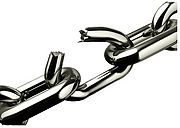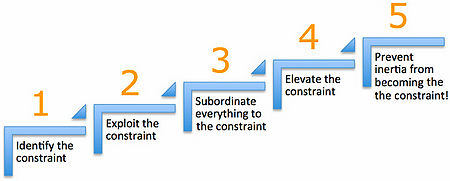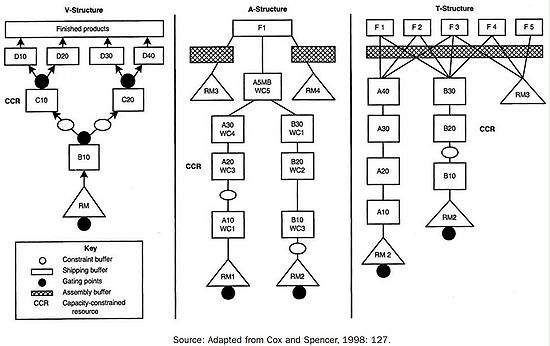Theory of Constraints
Developed by Niklas Schrøder
Contents |
Big idea
The theory of constraints (TOC) is a management paradigm that advocates improvement of a system by looking at constraints rather than the opportunities. The big idea of the theory is best described with the idiom: “a chain is no stronger than its weakest link”, meaning that the performance of the system is no greater than the limits of its constraints. System performance improvement is thus achieved by adjusting the system to the most limiting constraint.
Key assumptions
An assumption about the management of organizations has to be made in order to apply the theory of constraints. It is assumed that the work of organizations can be measured by looking at three key measures:
- Throughput, which is the rate at which the system generates revenue (e.g. the quantity of sold goods).
- Inventory, which is the money invested in the purchase of materials required to generate revenue (e.g. purchase of raw materials, outsourced components, etc.).
- Operational expense, which is the money spent on turning inventory into throughput (e.g. rent of factory, employee pay, costs of running machinery, etc.). [1]
Some necessary conditions must be met before applying the theory of constraints. Issues of safety, quality, legal obligations, etc. must be satisfied and cannot be included in the analysis of constraint. Where the goal for many organizations is to generate revenue, for NGOs it is a necessary condition to sustain themselves by making money. As a consequence of this, it is of utmost importance to possess financial expertise when making decisions regarding throughput, inventory, and operational expense. [1]
Concepts of TOC
The five focusing steps
The theory of constraints assumes that the performance of a system is limited in achieving its goals by at least one constraint. By identifying the most limiting constraint, improvements to the performance of the system can be introduced. Examples of system improvements can be either to increase the throughput or to decrease the operational expense.
The five focusing steps describe the process of applying the theory of constraints:
- Identify the constraint(s) of the system.
- Decide how to utilize the constraint(s) in order to improve the system.
- Make the exploit of the constraint(s) a top priority and rearrange the rest of the system to the previous decision.
- Implement the changes and dissolve the limiting constraint(s).
- Be aware whether a constraint has been broken in the previous steps. If so, begin the process from step 1 again. [2]
The steps are designed to focus on the constraints of a system in order to improve it by recognizing and utilizing them to the advantage of the system.
Types of constraints
Basically, a constraint can be anything that limits the performance of a system and prevents a it from attaining its goals. Constraint can take many shapes and be found in many place, but within the theory of constraints only the most limiting constraints are taken into consideration. Internal constraints are evident when the system is incapable of satisfying a given market. The removing of an internal constraint will allow for a greater throughput and thus attempt to satisfy the market. External constraints are evident when the demand from a given market is less than the capacity of the system. In this case, measures must be made in an attempt to increase the demand for its throughput. Another external constraint could be the lack of raw material or outsourced components.
More specifically, internal constraints include:
- Equipment
- - Insufficient number of machines.
- - Poorly utilized equipment.
- - Understaffed work stations.
- - Outdated equipment, etc.
- People
- - Lack of skilled employees.
- - Underskilled employees.
- - Lack of motivation among the employees.
- - Poor work environment, etc.
- Policy
- - Behavior patterns.
- - Attitudes.
- - Lack of information.
- - Assumptions, etc.[3]
Broken constraints
A constraint is said to be broken when it seizes to be the limiting factor of the system. Breaking a constraint is thus equivalent to having successfully removed the constraint for the system, and the five focusing steps will now allow for location and erradication of the next limiting constraint.
Buffers
In production, a constraint in the form of a bottleneck can often be alleviated by placing buffers before and after the constraint itself. A buffer is like a small inventory filled with work in progress parts just waiting to be processed by the constraint. By doing so, the constraint is assured to continue production despite failures elsewhere in the production facility. Placing a buffer behind the constraint secures the constraint from being affected by breakdowns and failures further down the production line.
It is possible to utilize non-physical buffers when it comes to e.g. project management. Properly scheduling and insertion of "time-buffers" can avert probable delays or setbacks.
Types of plant structures
There are four different types of plant structures in the theory of constraints. The type of plant structure allows for potentially easier location of constraints.
- I-plant: The material flows in a single line until it is finished. The constraint is the machine or step in production with the longest process time. An example could be the production of screws and nails.
- A-plant: The material flows from several lines to a converging point becoming a single product. The constraint is often found in the converging point as synchonization of materials/parts from different lines can become an issue. If the converging point is not adequately fed with required materials/parts, unnecessary waiting time will occur. An simple example could be the production of tables and chairs (requiring table tops, seat, and legs for both).
- V-plant: The material flows from a single source to become many different products. The constraint is often what is referred to as "robbing" where one subsequent work station will drain the majority of materials/parts, leaving other subsequent work stations starving for input. Correctly monitoring and managing the diverging point will aid in avoid this constraint. An example could be a steel manufacturer, producing both rods and sheets from ore.
- T-plant: The general material flow is as described for the I-plant, but the T-plant produces many different products using some if not all the same components, but in different combinations or assemblies. The constraint can be similar to that of both the A-plant and the V-plant. An example could be a computer (or just electronics) manufacturer.
These are the primary bases for plant types. They can be brought together in a number of ways for specific systems.
Applications
The theory of constaints can be applied to a wide variety of industries including production, marketing, supply chain management, administration, and project management. Whereever there is a need for optimization of processes or activities, the theory of constraints can be applied if modified appropiately.
The benefits of utilizing the theory of constraints is manyfold, examples being:
- Decreased production lead times.
- Improved quality of products and services.
- Dramatic increases in profitability.
- Reduced inventory levels.
- Reduced bottlenecks.
- Management of constraints.
- Curbing of statistical fluctuations.
- Improved competitive position.
- facilitation of strategic marketing and operational decisions.
- Introduction of the marginal pricing concept.
- Application of continuous improvement at the supply chain level.[3]
Project management
Using the theory of constraints, most projects can easily be viewed as A-plants, where a number of different tasks need to come together for a single deliverable. This can be useful for discovering time schedule-related bottlenecks and deal with them accordingly, e.g. by making sure to implement appropriate buffers.
This approach to project management can additionally be coupled with Critical Chain Project Management, as this concept removes the implicit assumption of infinite capacity as opposed to the standard concepts of Critical Path Method (CPM) and Program Evaluation Review Technique (PERT). [4]
Limitations
A major part of the theory of constraints is the identification of constraints because this is the basis for the rest of the work done (the five focusing steps). If the most limiting constraint is linked to other constraints in the system, and the practitioner is unable to map this in the identification step, there is a high risk of spending unnecessary time and resources trying to elevate constraints that are irrelevant to the achievement of goals.
Looking at the 3rd step of the five focusing steps, rearranging the entire system around one constraint may create even worse constraints elsewhere in the system. Only focusing on the single most damaging constraint can divert attention from areas in which the next constraint may be found.
The constant search for constraints to be elevated can only be satisfied once the system is indeed perfect, which will never happen. There are simply too many impacts on a system, both internal and external, to achieve perfection, and thus long-run considerations and the improvement of non-constrained areas might be neglected.
Corporate strategies are not taken into account either and what seems like apparent solutions might end up leading organizations away from other goals.
References
- ↑ 1.0 1.1 Goldratt, Eliyahu M. (1990). Essays on the Theory of Constraints. North River Press.
- ↑ Goldratt, Eliyahu M. (1984). The Goal: A Process of Ongoing Improvement. North River Press.
- ↑ 3.0 3.1 McNair, C. J. (1999) Theory of Constraints (TOC) Management System Fundamentals. Institute of Management Accountants.
- ↑ Goldratt, Eliyahu M. (1997). Critical Chain. North River Press.
Annotated bibliography
- Goldratt, Eliyahu M. (1990). Essays on the Theory of Constraints. North River Press.
- A collection of publishings by Goldratt on the theory of constraints. Relevant for those who wants to read more in depth about TOC.
- Goldratt, Eliyahu M. (1984). The Goal: A Process of Ongoing Improvement. North River Press.
- This is Goldratt's first publishing about the theory of constraints. It explains the premises and application of TOC. Very relevant for whomever is interested in TOC.
- McNair, C. J. (1999) Theory of Constraints (TOC) Management System Fundamentals. Institute of Management Accountants.
- This is a paper that outlines the theory of constraints and applies it in mostly a financial approach. Relevant for those who want a quick overview of the theory.
- Goldratt, Eliyahu M. (1997). Critical Chain. North River Press.
- The book is explaining the methodology behind in more depth, so this is for the reader who wants to know more about this specific approach and thus it does not revolve around TOC itself.


